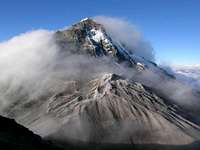|
|
Area/Range |
|---|---|
|
|
1.75754°S / 79.45312°W |
|
|
Hiking, Mountaineering, Trad Climbing, Ice Climbing, Mixed |
|
|
Summer, Winter |
|
|
Overview / Introduccion
The Cordillera Occidental (Western Range), runs north - south the length of the country. West the land descends to the Pacific coast and to the east sits the Interandean region, a high altitude valley. Chimborazo, Ecuador's highest peak, belongs to this mountain range. The Occidental doesn't have the amount of volcanic activity found in it's sister range to the east but it isn't dormant either. Most notable is Guagua Pichincha, young or baby Pichincha, which has active vents and who's ash is the reason Quito residents and businesses may keep a supply of surgical masks nearby.Mountains / Montañas
Ecuador has 10 mountains over 5000m (16,400ft). Six of these are found in the Cordillera Occidental. Chimborazo is the tallest and most famous of the range and the highest in Ecuador. Information on all these mountains can now be found right here on SummitPost. Additionally there are several interesting 4000m and lower mountains that make good acclimatizaton opportunities.
| 6000m + Mountains | ||||
|---|---|---|---|---|
| Overall Rank | Name | Height (meters) | Height (feet) | Easiest Route |
| 1 | Chimborazo | 6,310 | 20,561 | |
| 5000m + Mountains | ||||
| Overall Rank | Name | Height (meters) | Height (feet) | Easiest Route |
| 5 | El Altar | 5,319 | 17,451 | |
| 6 | Iliniza Sur | 5,263 | 17,267 | |
| 8 | Iliniza Norte | 5,126 | 16,818 | |
| 9 | Carihuairazo | 5,020 | 16,469 | |
| 4000m + Mountains (not comprehensive) | ||||
| Cotacachi | 4,939 | 16,204 | ||
| Corazón | 4,788 | 15,704 | ||
| Chiles | 4,723 | 15,495 | ||
| Pichincha (Guagua) | 4,675 | 15,334 | ||
| Atacazo | 4,463 | 14,638 | ||
| Quilotoa | 3,914 | 12,841 | ||
Interandean Region
This region is not geologically part of the Cordillera however it is often thought of in that sense because it lies to the west of the Pan American highway.Weather / Tiempo
Ecuador has two seasons, the dry and the wet, each of which is experienced twice a year. There is no summer and winter. Mountaineers will naturally be interested in the two dry seasons. Although that sounds simple it is further complicated by the influence of the Pacific Ocean and the Amazon Basin. The Cordillera Oriental (Eastern) tends to have the wetter overall weather. The driest months are December through February. In the west, the Cordillera Occidental is driest June - August and to a lesser degree December and January. In addition to moisture, wind can be a problem. August is known as a particularily windy month, and the winds can be strong enough to make parties turn around. Since most climbers visit both ranges the best time of year is theoretically December and January.Most groups base themselves in Quito which lies between the two mountain ranges.
Quito Weather (English)
All this talk of weather must be put in perspective. Ecuador's mountains can truely be climbed year round so don't abandon all hope if it isn't the "right" month. It is probably more important to get an early start. By mid morning the mountains are often clouding up.
Quito
The capital city of Quito is commonly used as a base for climbs in the Cordillera. All the mountains are reached, at least initially, via the Panamericana. Some of the mountains are a few hours away.Some of the acclimatization peaks are done in one day from Quito so climbers would be back in their beds at the end of the day. Longer climbs mean that climbers usually will leave mid-late morning and arrive at the refugio or campsite in the afternoon. They return to Quito around midday the following day.
Popular Climbs / Rutas Populares
The Cordillera Occidental is home to Chimborazo, the roof of Ecuador, and the country's only 6000 meter peak. This is a common goal of foreign and local climbers alike.A summit that sees more visitors is easily Iliniza Norte however. With a lower altitude and a summit attainable by a short scramble Norte is probably the number one acclimatization climb for climbers and a respectable goal of trekkers.
Rucu and Guagua Pichincha are also extremely popular peaks with easy hiking access.
Dangers / Pelegros
Sadly Ecuador is not without dangers of the human sort: assault, robbery, and theft. I consider Ecuador to be higher risk than many other South American destinations. So be aware. It is common to have something stolen.This same sort of risk is present on all the "trekking" peaks of Ecuador. You'll be safe on the glaciers but you'll want a lock on the locker back in the hut.
Rucu Pinchincha is particularily bad.


